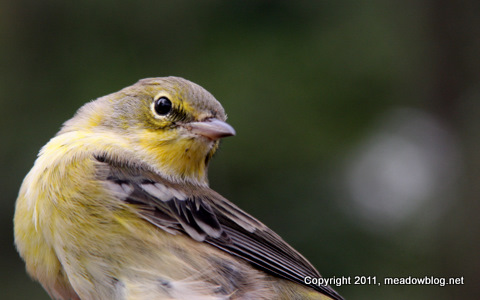
NJMC Naturalist Mike Newhouse banded this beauty last Tuesday. It's a Bay-breasted Warbler. (We said it was terribly tough.)
Congrats to Pat for getting the right answer… Did the hint in the Comments section help?
More on Bay-breasted Warblers here.

Wow–really? The undersides of the toes are yellow, which is a Blackpoll character; they’re bluish gray in Bay-breasted. I would still believe that this is a Blackpoll.
I’ve never seen a Bay-breasted this yellow-looking?!? What a strange looking bird…
Tricky, tricky, tricky. The legs also made me think “blackpoll”, but the hint in the comments made me guess that if it were a bay-breasted, it must be immature. Then I thought maybe I had missed a clue in the tail, because I didn’t pay enough attention to it the first time I looked at the photo – it looked totally different second time around.
Always something new to learn. If I’d seen that bird while out birding, I would have gone mad, and then it would have been a “warb. sp. – 1” for sure. 😉
Always fun. 🙂
A dern good puzzle.
Since we’re all learners here (and since id-ing birds from photos can be difficult), it would be helpful if you could provide the ID points that tipped the scale toward Bay-breasted, and/or which eliminated Blackpoll.
Perhaps the banders took measurements (wing chord?, tail? bill?) that nailed the ID?
Please note: the point made in the first comment below is important. The bird appears to have yellow soles. My big fat warbler reference says a decisive feature of a fall Blackpoll in the hand is that the soles of the toes and feet are yellow. (On a Bay-breasted they are not).
Also, on a much more subjective point, this bird appears to have Blackpoll-ish gray tones (instead of greenish) on the sides of its neck. (See Mr. Sibley)
Finally, from a migration-departure standpoint, Blackpolls are the much more likely candidate (they peak in NJ from mid-Sept to mid-October). Bay-breasteds, however, peak in Sept; with only a few stragglers passing though in early October. This bird was banded on Oct 4.
IDs from photos are difficult. And close ups even more so, at least for me, because I can’t get a reference or grip on the size of the bird.
So as far as ease of ID goes, sometimes a bird in the bush is worth two in the hand. (sorry, couldn’t resist that one)
Thanks again for a stimulating quiz.
I couldn’t figure this one out and I didn’t see the “bay” hint. Now that the identification has been revealed, however, I would tend to agree with it. Without overwhelming myself with too many details, it now seems obvious. If you look carefully at the sides of the bird, there defintely exists a tinge of that peachy, rosy color to the feathers on the flanks and lower breast. Definitely a bird in transition, but the sweetly buffy, rosy, peachy flanks seem to give it away.
http://www.flickr.com/photos/r101/6207554328/